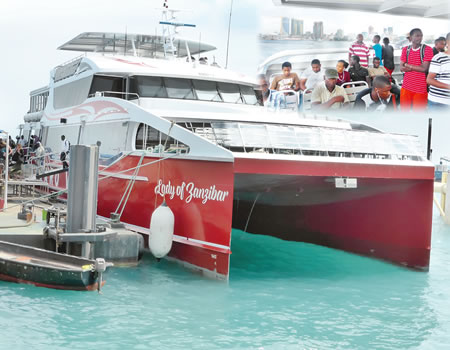Earlier that morning, I had left my northern Tanzanian base of Bagamoyo for the Nigerian Embassy in Dar Es Salaam where the embassy driver, Idi was waiting to take me to the Ferry Station in the downtown section of the city. Eager to make my visit to Tanzania as comfortable as possible, the ever helpful Nigerian Ambassador, H.E. Salisu Umaru had suggested that I travel to Zanzibar by air. ‘’It is just a 15 minute trip and it is safer and less stressful than a boat trip,’’ he said.
However for me, adventure comes before comfort so I opted for the 2-hour boat trip instead. That was when I was laden with some instructions for my ‘safety’. Apart from the need to purchase the $35 ticket a day ahead of my departure date, I was also asked to come with my International Passport and Yellow Fever vaccination card for the purposes of immigration formalities. In addition, I was advised to avoid the top deck of the boat because of the sea sickness caused by the huge waves which could make the ferry to rock vigorously.
As ‘The Lady of Zanzibar’ continued on her journey, I observed that the top deck economy section where I was seated was full of Tanzanians while the VIP and Business Class sections were made up of foreigners. It was also very obvious that the economy cabin had been overbooked with many passengers having to seat on the floor and in the aisles with their wares scattered everywhere. And when I recalled that previous boat mishaps in Tanzania had been caused by overcrowding, my heart missed some beats.
Fortunately, ‘The Lady Of Zanzibar’ did not appear to be in any form of danger despite being overcrowded as she continued to glide smoothly on the Indian Ocean which is said to be the warmest ocean in the world. Far into the horizon was a lovely and calm turquoise blue ocean, while overhead, a column of dainty white sea birds with golden beaks flew gracefully.
No doubt, the gentle swaying motion of the boat coupled with the fresh oceanic air and surrounding serenity was very sedative for before long, almost half of the passengers in the top deck were asleep. I could see the Tanzanian women on the floor and the aisles in their colourful ‘kangas’ (wrappers) fast asleep in the midst of their wares. Even for me, despite my resolve to stay alert to witness the beautiful environment around me, I soon found myself fighting sleep as I yawned endlessly.
For a while, the horizon emptied out with nothing in sight for miles. We were like this until about 11.20am, when suddenly, a thread of distant land materialized out of the mist, as Zanzibar came into view. Close up, I was dumbstruck by the beautiful panorama of Zanzibar’s main city, Stone Town that soon came into full view with buildings which I later identified as the Sultan’s Palace, House of Wonders, the Forodhani Gardens and St Joseph’s Cathedral all tumbling down to a calm bay dotted with an array of shipping vessels and gaily coloured little boats.
We finally docked at 11.35am, exactly two hours after leaving the port at Dar Es Salaam and were welcomed with a huge sign of KARIBU ZANZIBAR (Welcome to Zanzibar). Next to this sign was another one with immigration instructions from The Revolutionary Government of Zanzibar. And as I disembarked by the gangway, I noticed the clear, turquoise-blue water of that part of the Indian Ocean lapping the shoreline. This was in sharp contrast to the muddy waters of the same ocean at the beaches in Bagamoyo and Dar Es Salaam. Gaily displayed on the water front were a colourful array of small boats with fanciful names such as FACEBOOK, DRAGON, TAMBO, EQUATOR, BLUE WHALE and LADIES FREE, among others. The boats, I was told were to convey tourists on sightseeing to different parts of the Island. As a foreigner, I had to join an hour long queue for immigration.
Zanzibar is a semi-autonomous region of Tanzania in East Africa. It is composed of the Zanzibar Archipelago in the Indian Ocean, 80 kilometres (28 miles) off the coast of the mainland, and consists of many small islands and two large ones: Unguja (the main island, referred to informally as Zanzibar) and Pemba Island. The capital is Zanzibar City, located on the island of Unguja. Its historic centre is Stone Town, which is a World Heritage Site. The name Zanzibar is derived from the Persian zang-bâr signifying «black coast».
Outside the ferry terminal, I was met by a barrage of porters, taxi drivers and tourist guides who were eager to offer their services. However, following instructions from a Tanzanian friend, I waded through the crowd and turned right on the road outside the terminal. Meandering through the narrow streets in the hot humid weather, I visited the National Museum, the Tower Harbour, the old Castle as well as a monument to the slaves of Zanzibar. The Zanzibar’s slave market I was told was finally closed down in 1873. I was equally fascinated by the Old Dispensary, a beautiful four-storey colonial building which had now been turned into a Hotel/Gallery where a young artist had displayed his wares of artefacts and paintings.
I was a bit disappointed though at the decrepit state of Stone Town with some of the historically important buildings falling apart while others appeared seedy and unkempt. Things were so bad that at one point during my tour, I became terrified as I made my way through some narrow alleys ominously sandwiched by some precariously tilting and crumbling buildings which were propped up in places by steel stilts. ‘These are ancient monuments that must be preserved for posterity’ was the response from a Tanzanian friend when I suggested that the buildings should be demolished as they constitute danger to tourists.
Things brightened up later when I ventured into the shops where an array of spices, exquisitely woven fabrics, mementoes, perfumes and oils were on display. Thus, I was able to purchase some wonderful works of arts and souvenirs. Since Zanzibar is said to be an autonomous region, I was surprised to see that the Tanzanian currency was also the official currency on the Island.
It was late afternoon before I was able to tear myself away from the fascination of Stone Town to catch the boat for the return trip to Dar Es Salaam. Unlike our morning trip, passengers on the return trip were very few and everybody was seated with some empty seats remaining. At exactly 3.30pm ‘The Lady of Zanzibar’ blew her horn and headed back to Dar in almost the same way it had arrived Zanzibar a few hours earlier. Having been forewarned about the likelihood of stormy weather on the afternoon trip, I heeded the advice of avoiding the upper deck and so moved to the mid cabin. And just as I was thinking that we would escape the turbulence, mid-way into our journey, heavy waves hit the boat and the massive marine beauty became a mere toy at the hands of nature as she listed and bobbled heavily on the ocean water. And while some passengers found the listing and bobbling delightful through their ‘whao- whao’ sounds each time the boat rocked, others became apprehensive. Very soon, a sizeable number of the passengers became sea sick and requested for vomit bags which were quickly passed around. Fortunately, the rough weather soon passed and we progressed in good weather for the remaining part of our destination. Just before our arrival in Dar Es Salaam, I went to the upper deck to watch the approaching skyline of the ‘City of Peace’ which emerged in the approaching twilight, a magical city of beautiful people.






